Free Experiments
-
Posted: July 26, 2017Categories: ChemistryRead more »
Popping Test Tube
How many times can you make the stopper pop from the test tube?
Suitable for kids aged 7+, with adult supervisionCAUTION- The plastic stopper in the test tube is a projectile and must be aimed away from people and faces.
- The alka seltzer tablet is a medicine. DO NOT EAT. Seek medical advice if ingested by a child.
You Need:- Test tube with stopper
- Alka seltzer tablets
- Water
What to do:- 1/4 fill the test tube with tap water.
- Break an alka seltzer tablet into pieces and put about 1/4 into the test tube of water.
- Push the stopper into the top of the tube. You can either hold the tube or leave it standing on
-
Posted: July 26, 2017Categories: ChemistryRead more »
Grow Crystals
Grow your own crystal icicle using baking soda and water in about a week
Suitable for kids aged 5+ with parental supervision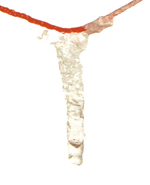 You Need:
You Need:- Two glass jars
- Two paper clips
- A length of thick woolen thread
- Baking soda
- Shallow dish
- Spoon
- Very warm water
What to do:- Fill two jars with very warm water.
- Add spoonfuls of baking soda one spoon at a time and stir into each jar. Keep adding baking soda until you cant dissolve any more and you have a supersaturated solution.
- Attach a paper clip as weight to each end of the thick thread.
- Lower
-
Posted: July 26, 2017Categories: ChemistryRead more »
Colourful Chemicals
Use cabbage water to change kitchen chemicals different colours.
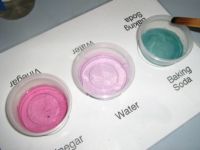 Suitable for kids aged 4+ with parental supervisionCAUTIONThe cabbage water must strictly be prepared by an adult as it involves the use of boiling water.You Need:
Suitable for kids aged 4+ with parental supervisionCAUTIONThe cabbage water must strictly be prepared by an adult as it involves the use of boiling water.You Need:- Small amount of red cabbage
- Pot of boiling water (to be handled only by an adult)
- Large container to drain cabbage water
- Baking soda
- Citric acid
- Plastic spoons
- Small plastic containers (labelled citric acid, baking soda, cabbage water)
What to do:- Important: have an adult chop half a red cabbage and
-
Posted: July 26, 2017Read more »
Welcome to Magefan blog extension for Magento® 2. This is your first post. Edit or delete it, then start blogging!
-
Posted: July 26, 2017Categories: MagnetismRead more »
Attract match sticks using a magnet and leave your friends guessing! Suitable for kids aged 8+ with adult supervision
You Need:
- Matchsticks (non-safety or 'strike anywhere' matches with the red head. work best).
- A strong neodymium magnet.
What to do:
- Open up a matchbox and select a number of matches.
- Place the neodymium magnet onto the heads (red) of the matchsticks.
- You'll observe that they do not attract or move towards the magnet.
- Burn the matches by striking them as normal, once head of match is burned you can extinguish it by blowing air onto it.
- Now repeat step 2 and place the magnet onto the matchstick heads, you should observe that they're attracted to the magnet! But how?
Why is it so?
- The red matchstick head is made from iron oxide and under normal circumstances it is not magnetic. So that's why you would of observed the unused/fresh
-
Posted: July 26, 2017Categories: MagnetismRead more »
Make a magnet that turns on and off with electricity. Suitable for kids aged 6+
CAUTION: Do not hold the wire on the battery for long periods without removing it. The wire and/or the battery terminal may get hot. The nail is sharp, handle with care.
You Need:
- Large nail
- Plastic coated wire (stripped of the plastic at each end)
- Battery
- Washer or paper clip (any metal object containing iron will work)
What to do:
- Wind the plastic coated wire tightly around the nail about 40 times - more turns makes a stronger magnet. It doesn't matter if the wire turns overlap.
- Hold one end of the stripped wire to one end of the battery (terminal), and the other end of the stripped wire to the other battery terminal.
- With the wire connected to the battery, pick up your metal object (washer or paper clip) with the sharp end of your new electromagnet.
- To turn off the magnetism,
-
Posted: July 26, 2017Categories: ElectricityRead more »
All you need is a piece of string and a plastic cup to make your own noisy, clucking chicken. Suitable for kids aged 4+ with parental supervision
What You Need:
- Plastic cup
- Piece of string (approximately 40cm long)
- Sharp pencil
- Masking tape
- Small piece of damp sponge (optional)
What to do:
- Have an adult pierce a hoe in the top of the plastic cup using the sharp pencil.
- Thread the piece of string through the hole and tie a knot at the end so the string wont come back through the hole (as shown in the picture). If you have trouble tying the knot, try wrapping a piece of masking tape around the end of the string to stop it from coming back through the hole.
- To make your chicken cluck: wrap your wet fingers or a piece of damp cloth (if you have one) around the string near the mouth of the cup, then move your fingers/sponge down the length of the string, holding the cup firmly
-
Posted: July 26, 2017Categories: ElectricityRead more »
Use static electricity to make a magic wand. Suitable for kids aged 4+
You Need:
- Polystyrene ball
- Plastic straw
- Piece of fabric (wool works best)
What to do:
- Wrap the piece of fabric around the plastic straw and rub up and down about 20 times.
- Place the now magic straw above the foam ball and watch it mysteriously jump to the straw.
- If it doesnt work the first time, rub the straw with the fabric and try again. Be patient.
- Try a different piece of fabric. Does this work better?
Why is it so?
When the straw is rubbed with the fabric it becomes electrified and has the power to attract things, like the polystyrene ball. This is static electricity at work. Read about how things become electrified below.
Super Charged
It is thought the ancient Greeks discovered electricity when they found that the mineral amber was able to attract light-weight
-
Posted: July 26, 2017Categories: ElectricityRead more »
Make an electrical circuit to light a bulb Suitable for kids aged 7+, with adult supervision
CAUTION
- The light globe is glass and misuse may cause it to break, resulting in sharp pieces that could cut skin. Use carefully.
- Do not hold the wire on the battery for long periods without removing it. The wire and/or battery terminal may get hot.
You Need:
- Small globe
- Globe holder
- Battery
- Short electrical wire x 2
What to do:
- Screw the light globe into the holder.
- Attach the end of a stripped piece of wire to one side of the globe holder, by threading it through the metal hole and twisting it in on itself to hold it in place. The copper wire (not the plastic coating) needs to be in contact with the globe holder for electricity to flow and power the bulb.
- Attach the end of another stripped piece of wire to the other side of the globe holder
-
Posted: July 26, 2017Categories: ElectricityRead more »
Get a propeller to spin in two different directions working like a propeller and a fan. Suitable for kids aged 7+, with adult supervision
CAUTION
- Do not put spinning propeller near peoples faces or hair. Hair could get tangled.
- Do not hold the wire on the battery for long periods without removing it. The wire and/or battery terminal may get hot.
You Need:
- Propeller
- 9V motor
- Battery
- Short electrical wire x 2
What to do:
- Attach the propeller to the 9V motor by pushing the motors spindle into the hole at the back of the propeller. Make sure its on tightly.
- Thread one end of a piece of stripped copper wire through the hole in the square metal ring on the motor. Twist the copper wire in on itself to hold it in place. The copper wire (not the plastic coating) needs to be in contact with the square metal ring on the motor for electricity to flow and

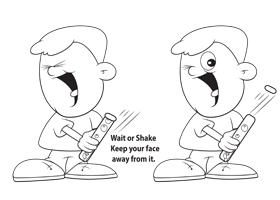
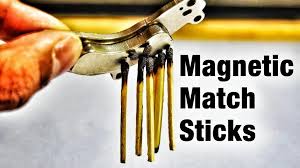
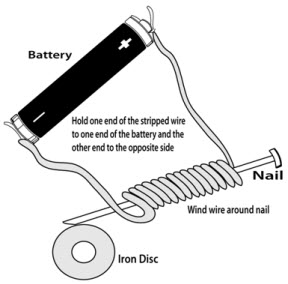

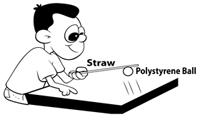
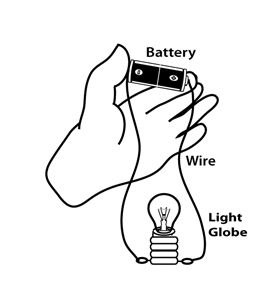
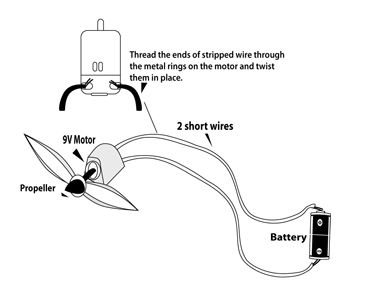

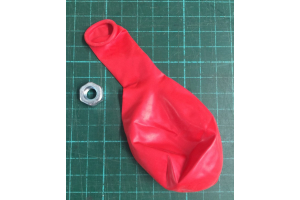
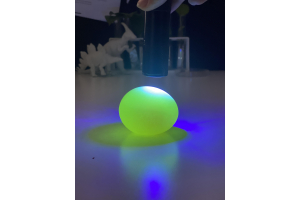


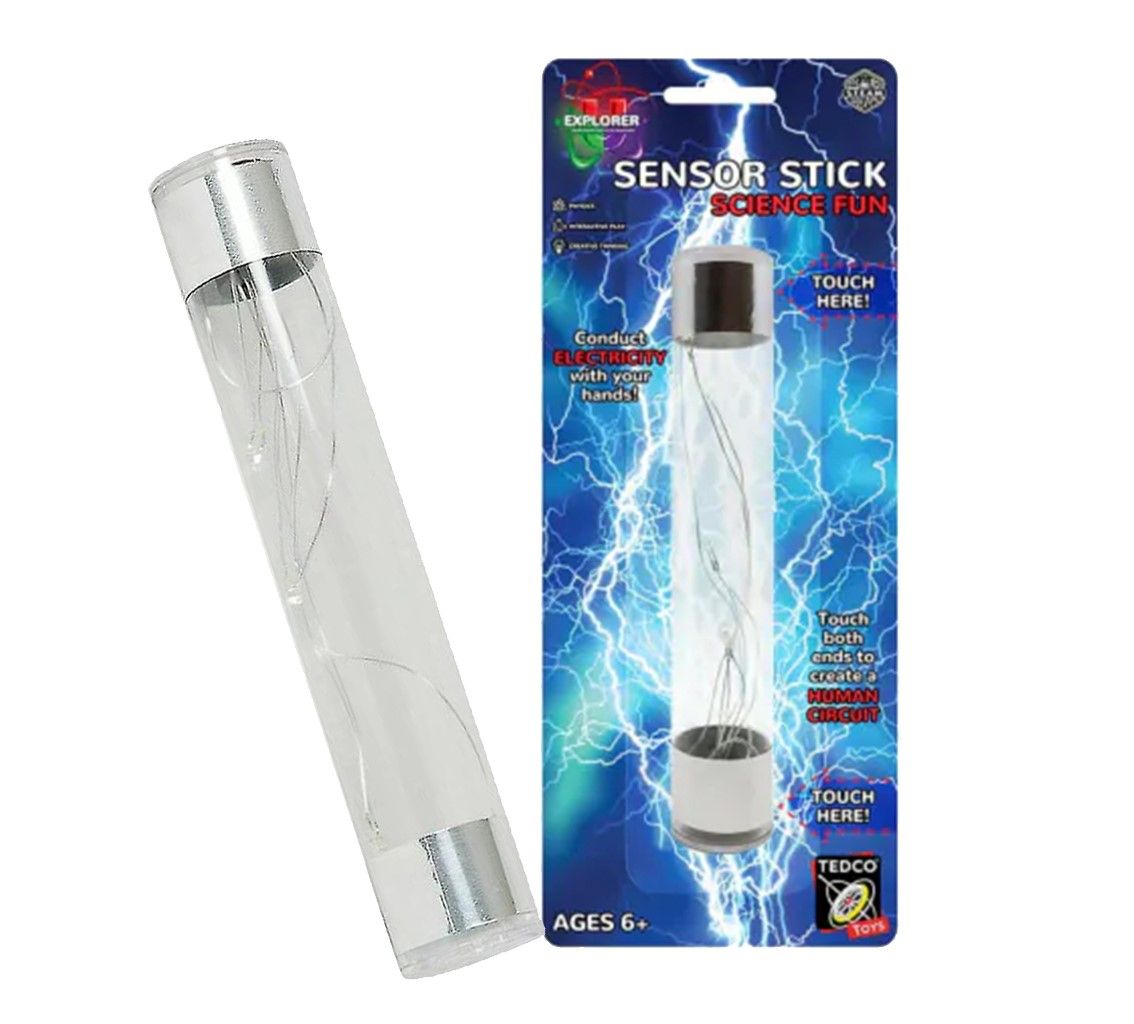


 magento3
magento3